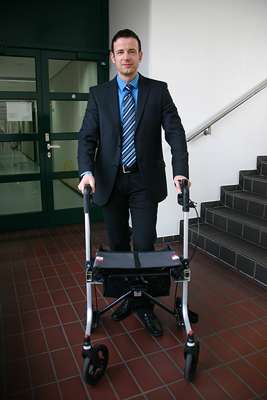A smart walker that guides its users

As part of the EU-funded DALi project, Siemens' global research unit Corporate Technology is developing a high-tech walker that can safely guide people with cognitive impairments through public buildings. Airports and shopping centers can pose problems for elderly people, as they might suffer an accident because they have difficulty seeing structural obstacles and signs in the crowded buildings. However, the new system is designed to not only make senior citizens' everyday life easier but also be used in industrial settings.
At the heart of the c-Walker is a cognitive navigation prosthesis. The walking aid is equipped with various imaging sensors, including the Kinect sensor, which Microsoft developed for the Xbox video game console. The sensor enables the mobile system to monitor its spatial surroundings in real time. Thanks to its numerous "eyes," the c-Walker knows not only where it is at any given moment but also where obstacles are located, in which direction people are moving, and even what warning and information signs say. This enables the device to orient users in unstructured environments and guide them to their destinations along optimal routes.
Siemens also plans to use this technology in industrial settings. Because automated production lines are often confusing, people and machines can quickly collide. However, the integration of the new system into portable panel PCs could enable people to interact with machines more safely and comfortably. For example, the devices could warn production workers against entering danger zones and show service technicians the best route through a factory.
The technology helps not only human workers but also their mechanicalcolleagues. It makes robots and ma-chines aware of their surroundings so that they can respond to external influences. For Siemens, this development is an important step toward creating a smart industrial environment in which people and machines can react to one another in order to increase work efficiency.
Siemens is also using the Kinect sensor in a virtual planning system for work processes. In this system, the Kinect technology recognizes an individual's movements and posture and transfers them to an avatar in a virtual environment. In the same way that a player moves intuitively within the scenes of a computer game, technicians can use Kinect to simulate movements in the workplace.
Provided by Siemens





















